Alexander Born in 1869
|
|
|
Franz Joseph Zugelder
1787-1852 |
 |
|
|
Franz Joseph Zugelder
1823-1903 |
|
|
|
|
Maria Agatha Grier
1786-1862 |
 |
|
Rev. Alexander F. Zugelder 1869-1960 |
|
|
Maria Anna Fassnacht
1829-1900 |
 Königheim, 1869-1888. Alexander Francis Zugelder was born January 6, 1869, in Königheim, which is on the Brehmbach River 67 miles southeast of Frankfurt in Baden (now the Main-Tauber-Kreis region of Baden-Württemberg). He was the third child of Franz Joseph and Maria Anna Fassnacht Zugelder. He had a sister Maria Magdalena who was born in 1860 and a brother Aloys who was born in 1862. Königheim, 1869-1888. Alexander Francis Zugelder was born January 6, 1869, in Königheim, which is on the Brehmbach River 67 miles southeast of Frankfurt in Baden (now the Main-Tauber-Kreis region of Baden-Württemberg). He was the third child of Franz Joseph and Maria Anna Fassnacht Zugelder. He had a sister Maria Magdalena who was born in 1860 and a brother Aloys who was born in 1862.
Alexander's paternal grandparents were Franz Joseph and Maria Agatha Grier Zugelder, both from Königheim. Both died before Alexander was born.
Alexander's maternal grandparents were Leonhard and Maria Anna Hauck Fassnacht, both from Königheim. Leonhard died before Alexander was born. Maria Anna died two months after he was born.
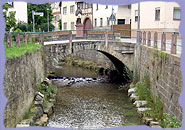
Brehmbach River, Königheim. Source Königheim Web site. |
|
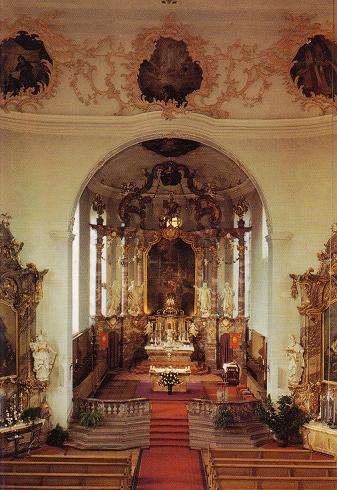
St. Martin Church, Königheim. Built between 1752 and 1756 in the baroque style by architect Michael Anton Mueller, a student of Balthazar Neumann. |
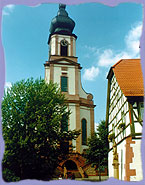
St. Martin Church, Königheim. |
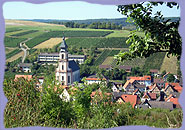
Königheim panorama. |
Alexander was educated in Germany through age 19.
Alexander had relatives in the United States. His mother's brother, Richard Fassnacht, and his mother's sister, Theresa Fassnacht, had emigrated from Königheim to Grand Rapids in 1853. They married a sister and brother. Richard married Mary Koch. Theresa married William Koch. William had emigrated from Württemberg in 1853. He was a ropemaker, then a furniture retailer, then an undertaker. The Kochs and Fassnachts were among the original German immigrant families who joined St. Mary's Church when it was formally organized in 1857 at 423 First Street NW, on the west side of the Grand River, a block north of Bridge Street. The Kochs had four children in Grand Rapids: William in 1857, August in 1858, Christine in 1860, and Frank in 1863. These children were first cousins of Alexander. In 1880, his cousin Christine Koch married Cris J. Smith, a musician, at St. Mary's Church in Grand Rapids. In 1882, they had had a daughter Rose Viola. On April 3, 1887, when Rose was 5, her mother, Christine Koch Smith, died.
Alexander also had a niece, Otilia Leuchtweis, who would be born in Königheim in 1889 and immigrate to the United States at age 9 in 1898, ten years after him. Otilia was the daughter of Father Zugelder's sister Maria Magdalena.
The relationship between Alexander Zugelder, his niece Otilia, and his cousin once removed Rose can be more easily understood by viewing the descendants of his maternal grandparents, Leonhard and Maria Anna Hanck Fassnacht, as shown below.
Richard Fassnacht b. 1822 m. 1858 Mary Koch b. 1826
- Johanna Fassnacht b. 1859
|
Theresa Fassnacht 1824-1888 m. 1858 William Koch 1827-1905
- William Koch 1857-1891 m. Anna S.
- August J. Koch 1858-1883
- Christine Koch 1860-1887 m. 1880 Cris J. Smith 1852-1932
- Francis X. Koch b. 1863
|
Maria Anna Fassnacht 1829-1900 m. 1857 Franz Joseph Zugelder 1823-1903
- Maria Magdalena Zugelder 1860-1893 m. 1888 Michael Joseph Leuchtweis 1860-1901
- Otilia Leuchtweis 1889-1963 m. 1917 John P. O'Hara 1890-1977
- Aloys Zugelder 1861-1888
- Alexander F. Zugelder 1869-1960
|
In 1888, Alexander's brother Aloys died at age 26.
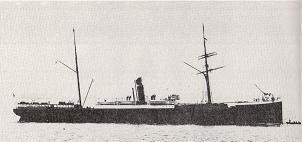
S.S. Toronto, 1880. Dominion Line. Source: The Peabody Museum of Salem. |
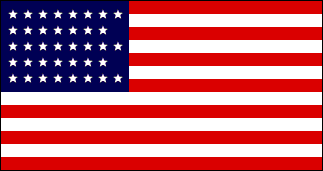 Grand Rapids, 1888. In July 1888, Alexander emigrated at age 19 from Königheim to Grand Rapids, Michigan, where his Aunt Theresa Fassnacht Koch lived. There were 38 stars on the American flag when Alexander arrived. The last state to be admitted was Colorado. Grover Cleveland was President of the United States.
Grand Rapids, 1888. In July 1888, Alexander emigrated at age 19 from Königheim to Grand Rapids, Michigan, where his Aunt Theresa Fassnacht Koch lived. There were 38 stars on the American flag when Alexander arrived. The last state to be admitted was Colorado. Grover Cleveland was President of the United States.
His 1897 passport indicates that he came to America on the steamship Toronto. The ship left Liverpool on July 6 and arrived in Quebec City on July 16, with stops in Belfast and Montreal. The ship was built in 1880 at Glasgow by Charles Connell & Co.
On August 3, 1888, Alexander Zugelder's aunt, Theresa Fassnacht Koch, died. In 1890, William Koch, 63, married Elizabeth Lavo, 48.
Milwaukee, 1888-1893. Alexander came to America to study for the priesthood. The Diocese of Grand Rapids had been carved out of the Detroit Diocese only six years earlier and would not have its own seminary until 1909. The diocese sent Alexander to Saint Francis Seminary in Milwaukee, Wisconsin, for four and one-half years. The Milwaukee Diocese had been carved out of the Detroit Diocese in 1843. The Seminary was founded in 1845 by John Martin Henni, the first bishop of the Diocese of Milwaukee. The Bishop saw an urgent need for priests to serve the growing number of Catholics, especially German immigrants, who were settling in the Midwest.
On November 28, 1888, Alexander's sister, Maria Magdalena Zugelder, married Michael Joseph Leuchtweis in Königheim. Michael was from Grossrinderfeld, 9.5 miles east northeast of Königheim. On September 1, 1889, they had a daughter Otilia.
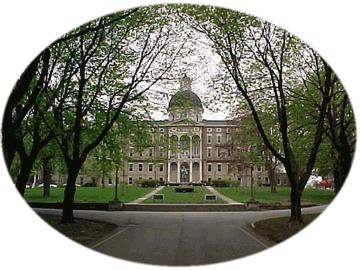
Saint Francis Seminary, Milwaukee, Wisconsin, where Alexander studied from 1888 to 1893. |
|
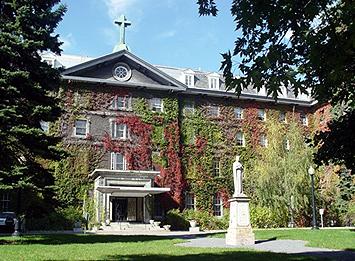
Grand Seminary of Montreal, where Alexander studied from 1893 to 1894. |
|
Montreal, 1893-1894. In 1893, the diocese sent Alexander to the Grand Seminary of Montreal for one and one-half years to study theology. The seminary was founded in 1840 by the Priests of St. Sulpice of Montreal at the request of Ignace Bourget, the bishop of Montreal.
On July 22, 1893, Alexander's sister, Maria Magdalena, died in Königheim. Her daughter, Alexander's niece, Otilia, was only 3 years old.
|
Father Zugelder Ordained in 1894
On June 29, 1894, Alexander F. Zugelder, was ordained at age 25 at St. Andrew's Cathedral in Grand Rapids by Bishop Henry Joseph Richter, the first bishop of the Diocese of Grand Rapids. He celebrated his first Mass in St. Mary's Church, 37 years after it had been started by German immigrants, including the Kochs.
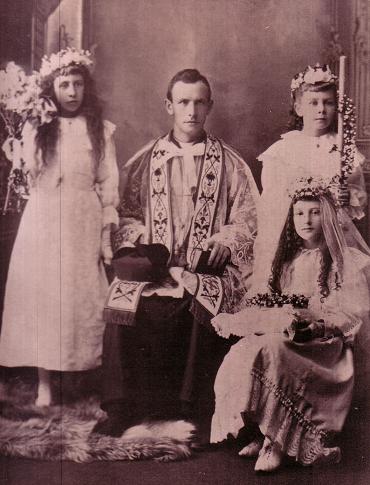
Photo probably taken in 1894 on the occasion of Fr. Zugelder's ordination or first Mass or perhaps the confirmation of Rose Viola Smith, his first cousin, once removed. Back row: Father Alexander F. Zugelder with two unidentified girls. Front row: Rose Viola Smith. |
|
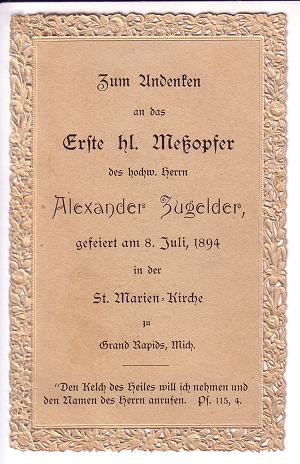
Holy card: "To commemorate the first Mass of Reverend Alexander Zugelder, celebrated on July 8, 1894, in St. Mary's Church in Grand Rapids, Mich." Bottom: Psalm 115, verse 4: "The cup of salvation I will take up, and I will call upon the name of the Lord." |
|
|
|

Rev. Alexander Zugelder was the fourth priest to be ordained from St. Mary's. Source: History of St. Mary's Church in Grand Rapids, Mich., 1907 (p. 40). |
|
Cadillac, 1894-1895. In 1894, Bishop Henry Richter gave Father Zugelder his first assignment for the Diocese of Grand Rapids, as pastor at St. Ann Church in Cadillac, Wexford County, Michigan. Cadillac is 95 miles north of Grand Rapids. The rectory he lived in may be the one shown on the postcard. He was in Cadillac for eighteen months in 1894 and 1895.
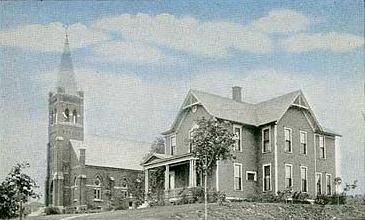
Postcard of St. Ann Church and rectory, Cadillac, Michigan. |
|
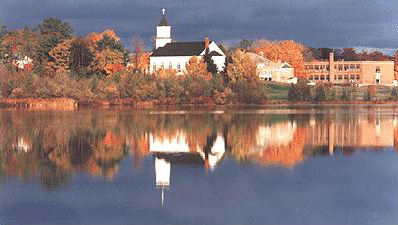
St. Mary of the Assumption Church, Lake Leelanau, Michigan. |
|
Lake Leelanau, 1895-1899. In 1895, Bishop Henry Richter gave Father Zugelder his second assignment for the Diocese of Grand Rapids, as pastor of St. Mary of the Assumption Church in Lake Leelanau, 160 miles north of Grand Rapids, near Traverse City. At the time Father Zugelder was in Lake Leelanau, it was called was Provemont. He was there for four years. During his time in Lake Leelanau, Father Zugelder built a rectory.
His 1897 passport indicates that he was naturalized as an United States citizen by the Circuit Court of Grand Traverse County on April 21, 1897. William Koch witnessed the passport application.
In 1898, Father Zugelder's niece, Otilia Leuchtweis, emigrated from Königheim to Grand Rapids at age 9. In the 1900 census, she was living with the Kochs. Otilia's father, Michael Joseph Leuchtweis, remained in Königheim when Otilia emigrated.
Beaver Island, 1899-1905. In 1899, Bishop Henry Richter gave Father Zugelder his third assignment for the Diocese of Grand Rapids, as pastor at Holy Cross parish on Beaver Island in Charlevois County, Michigan. Beaver Island is 227 miles north of Grand Rapids, including a 32-mile ferry ride out into Lake Michigan. He arrived on the fourth of July and was there for six years. He replaced an Irish priest, Father Gallagher, who died in 1898. His housekeeper was Mary Reynolds, a native of Ireland. In 1899, Father Zugelder petitioned for and got the Dominican Sisters of Marywood to come and teach in the parish. He erected two schools, a sisters’ house, and a rectory, and enlarged the church. He was the weatherman on the island and was instrumental in getting the telephone cable to the island.
In the 1900 census, Father Zugelder's niece, Otilia Leuchtweis, was living with the Kochs in Grand Rapids. William Koch had been married to Elizabeth since 1890. Father Zugelder's aunt, Theresa Fassnacht Koch, apparently died sometime during the 1880s.
While at Beaver Island, Father Zugelder's parents died back in Königheim. On July 26, 1900, his mother, Maria Anna Fassnacht Zugelder, died. Two and a half years later, on February 2, 1903, his father, Franz Joseph Zugelder, died.
In 1901, Fr. Zugelder was architect for a hotel that is now a private club called the King Strang Hotel.
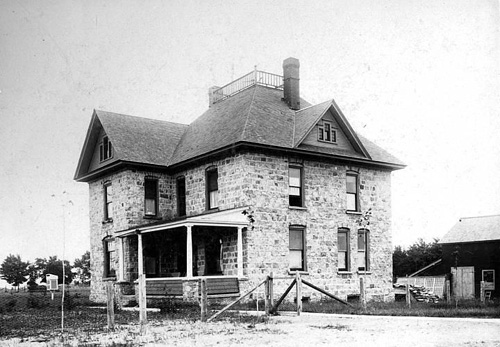
Rectory at Holy Cross Parish in Beaver Island, Michigan, 1903. |
|
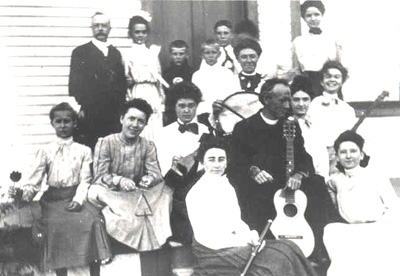
Fr. Zugelder's Band, 1903. Fr. Zugelder with a guitar and 14 other band members at Holy Cross Parish in Beaver Island, Michigan. Source: Beaver Island. |
|
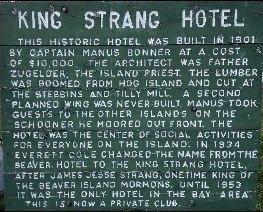
King Strang Hotel sign. Photo by Paul Drueke. |
|
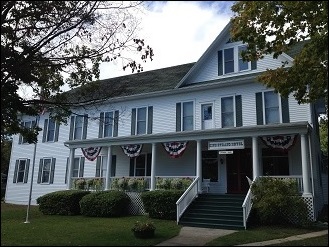
King Strang Hotel, Beaver Island, Michigan. Built in 1901. Architect: Fr. Zugelder. Photo by Paul Drueke. |
|
Charlevoix Sentinel December 18, 1902
Rev. Father Zugelder has the inside work on the new Parish stone house about completed and will move into it by New Year’s Day. Great credit is due the Father for his push and perseverance in accomplishing so much building and other improvements on the Parish property during the short time of his pastorate here.
Charlevoix Sentinel February 26, 1903
The Dominican Sisters have changed their residence from the harbor to the new Sisters’ home near the church.
Father Zugelder has recently moved into the new stone house which has just been completed. This elegant residence which is by far the finest dwelling on the Island is a credit to the Island and especially to the Parish and friends who built it. The congregation here is greatly indebted to their faithful pastor, Father Zugelder, who made it possible for the Parish to own such a handsome church house. The location of it could not have been better. The view from the highest point on the house where Father Zugelder has cleverly planned an observatory is magnificent, for one can see not only the whole north end of the Island with Font Lake so daintily nestled among the trees, but the north channel, the Harbor and point, all the neighboring islands in their picturesque beauty, and on a comparatively clear day, the north shore and the mainland to the eastward.
Charlevoix Sentinel May 14, 1903
The telephone line put in by Fr. Zugelder is in splendid working order. George Emery of Charlevoix put in the line.
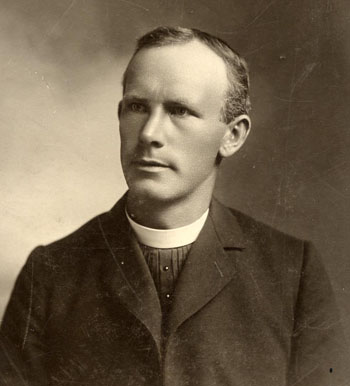
Photo of Father Zugelder. |
Charlevoix Sentinel August 4, 1904
Last week Prof. Cox and family and Rev. Father Zugelder had a two-day camping and fishing trip at Lake Geneserat, near the head of the Island. While on the Island, Prof. Cox settled the details of the proposed weather station there. The station will be placed on the high ground near the church and will be equipped with barograph and instruments recording wind velocity and weather. Rev. Father Zugelder will be the official in charge.
[Note: Prof. Henry J. Cox (1863-1930) was in charge of the North Central Forecast District of the U. S. Weather Bureau, headquartered in Chicago. In 1884 he entered the weather service of the Army Signal Corps, which in 1891 became the Weather Bureau of the Agriculture Department. In 1894 Prof. Cox was transferred to Chicago and in 1898 was placed in charge of a new North Central District. In addition to a Harvard A.B., Professor Cox had the degrees of A.M. and Sc. D., received from Norwich University in 1887 and 1914. He was past president of the Geographic Society of Chicago.]
Charlevoix Courier April 4, 2001
The Story of the Island's German Father Zugelder
by Robert Cole
Beaver Island Historical Society
For well over 120 years, Beaver Island was a largely Irish-American culture with close ties to the Catholic Church. The island's Holy Cross Parish was involved in more than just the religious life of its residents; it played an active role in the community's educational, social, and civic spheres as well.
From 1866 to 1898, Father Peter Gallagher had led the parish of Holy Cross. The Irish-born Gallagher's common heritage with the islanders, along with his fluency in Gaelic, helped to embed the priest among his people for thirty-two years.
Upon his sudden death at 67, the congregation found itself at a loss. The islanders appealed to the diocese for a permanent replacement, but it would be almost another year before an available priest could be found. The locals must have waited with some uncertainty as well, for Gallagher's passing was the end of an era, and the future shape of the local Church an unknown quantity.
It was against this backdrop that Father Alexander F. Zugelder arrived in St. James Harbor on July 4, 1899. Born and educated in Baden, Germany, he had led two Michigan parishes prior to his arrival on Beaver Island. After years of building up each pastorate he had served, the 33-year-old cleric had volunteered to lead the island mission.
Zugelder applied a sense of practical foresight to his new station on the rural island. He transferred to Holy Cross upon the condition that two nuns join him there. The Diocese of Grand Rapids and the Dominican Order there agreed to his request. The Order offered to include two additional Sisters, one a musician, the other a cook and housekeeper. These four nuns were to be the first in a long tradition of Dominican teachers to serve the Island's school system over the next 90 years.
He rented a small house for himself on the harbor and had the nuns set up in a home across the street. The building next to the Sister's abode had been a saloon; Zugelder quickly made arrangements and by the Spring of 1900, the tavern had been converted into a chapel.
The Father next set his sights on the Parish complex. Situated near a hillside cemetery a mile south of St. James were the church and an adjoining one-story rectory built in the 1860s. The rustic buildings had changed little since their construction. The priest used his natural affability and determination to raise large donations of money and labor to conduct major renovations. He had the church nearly doubled in size, added a choir loft, and installed a hot air furnace. Later, the original wood-frame rectory was razed and replaced by a new convent in 1901, into which the Sisters relocated from their harbor residence.
In 1902 Father Zugelder began work on a new rectory sited across the street from the church. Calling on nearby farmers to collect stones and large boulders from their fields, construction began on a two-story cobblestone edifice with walls twenty inches thick, replete with a rooftop deck for observation. Finding work delayed due to lack of volunteers, local legend has it that in response the good Father lit a nearby woodshed afire; when men scurried in to the area to help, they found the shed in ashes. Having a captive labor pool this assembled, Zugelder promptly put them to work.
Completed in 1903, the new rectory drew the praise of the Charlevoix Sentinel's editor Willard Smith: "Father Zugelder's house is the best on the island (and) the location of it could not have been better. The view from the highest point of the house was cleverly planned...one cane see the whole north end...the harbor and point, all neighboring islands, and the north shore of the mainland on a clear day."
The material improvements in Holy Cross Parish certainly bolstered his congregation's sense of pride; yet Father Zugelder's contributions were not limited to bricks and mortar. He was, more importantly, an accessible touchstone in his people's spiritual and cultural life. During his six years there, weekly mass attendance doubled. Beyond his clerical role he was active as a counselor, leader of musical groups, and organizer of community gatherings.
He strove to raise his flock's own latent sense of religious purpose, reaching across presumed ethnic barriers to speak to the immigrant population in terms relevant to their cultural identity. As Zugelder's friend Willard Smith attested, "It is clearly seen that...he is partial to the Irish, and they, in return, are very fond of him and highly appreciate his labors for their spiritual and temporal welfare." That a German-born pastor could so skillfully effect these changes within an isolated Irish community a century ago reveals much of his vision and breadth of spirit.
Having shepherded his parishioners into a new century and deepened sense of spiritual and cultural purpose, Father Zugelder's pastorate at Holy Cross Parish ended in 1905. Today, the buildings he helped create and improve still stand on Beaver Island. Though now the church has been moved into town, and the other structures serve different purposes, his legacy, both tangible and intangible, remains.
USGENWEB Site for Isabella County, History of Beal City Undated, unsigned.
Father Zugelder thought the soil of Beaver Island could be made to yield a paying crop. Accordingly, when the land-owners there were offered contracts for raising peas for a seed company he encouraged them to try it. They did so and raised a very good crop of peas, receiving a price that encouraged them to try a second year of peas. While not so good as that of the first year, a fairly remunerative crop rewarded their efforts. Then Father Zugelder got busy among them. “Put something back in the soil, or you will run it out.” he told them. They listened respectfully, but, being fisherman and not farmers, not many heeded this sound advice, with the result that the third year’s crop was a distinct disappointment.
Beal City, 1905-1950s. In 1905, Bishop Henry Richter gave Father Zugelder his fourth and last assignment for the Diocese of Grand Rapids, as pastor of St. Philomena parish in Beal City, Nottawa Township, Isabella County. Beal City is 81 miles northeast of Grand Rapids. The parish and town were established in 1892. The church that Fr. Zugelder knew was on what is now called West Beal City Road. It has since been moved from West Beal City Road, around the corner to North Winn Road. In 1961, the name was changed from St. Philomena to St. Joseph the Worker.
In 1907, St. Mary's Church in Grand Rapids celebrated its Golden Jubilee. Father Zugelder served as subdeacon at the solemn consecration of St. Mary's Church by Bishop H. J. Richter prior to the Jubilee celebration. Father Zugelder was the fourth priest to be ordained from St. Mary's. He said his first Mass at St. Mary's Church on July 8, 1894. His photo is included in the 1907 History of St. Mary's Church in Grand Rapids, Mich. with seven other priests who had said their first Mass at St. Mary's Church.
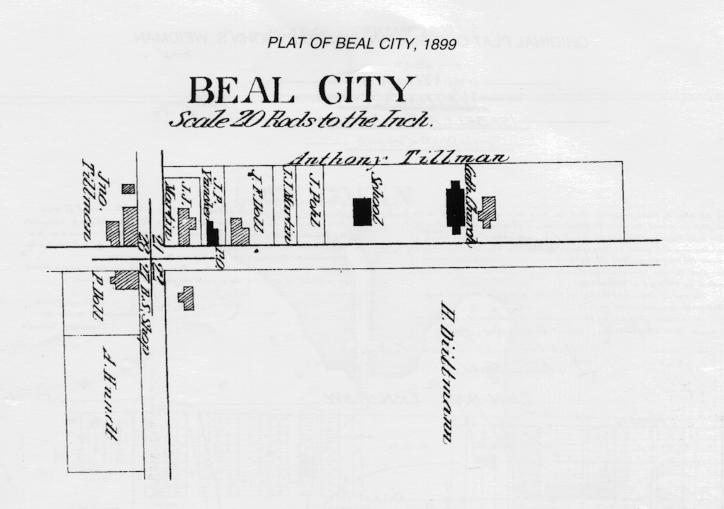
Beal City Plat Map of 1899 showing School and Cath. Church (and Rectory). |
|
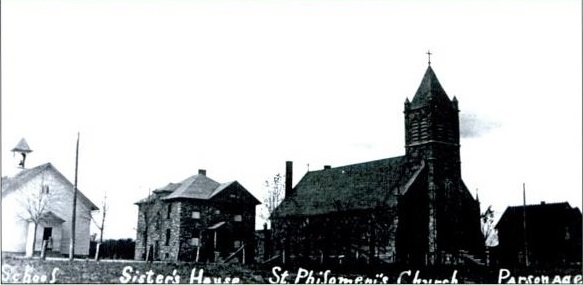
Photo, circa 1910, showing School, Sister's House, St. Philomena's Church, and Parsonage. |
|
In 1909, Father Zugelder's niece, Father Zugelder's niece, Otilia Leuchtweis, graduated from Holy Rosary Academy, a girl's boarding school run by the Dominican Sisters in Bay City, Michigan.She had also attended high school in Grand Rapids.
In the 1910 census, Otilia was residing in Beal City with Father Zugelder, and attending college. Otilia attended the University of Michigan from 1909 to 1913 and in 1912 became a founding member and first president of of Theta Phi Alpha fraternity for Catholic women.
A history of Isabella County published in 1911 includes comments about Father Zugelder and St. Philomena Church. It appears on the USGENWEB site for Isabella County.
Past and Present of Isabella County Michigan, by Hon. Isaac A. Fancher, 1911
REV. ALEXANDER FRANCIS ZUGELDER
The beloved pastor of St. Philomena's Roman Catholic church in Nottawa township and one of the popular priests of the diocese of Grand Rapids, was born January 6, 1869, in Konigheim, Baden, Germany, and spent the early part of his life in the land of his nativity. He was primarily educated in the gymnasium schools of Baden, where he pursued his studies until his nineteenth year, when he came to the United States and during the four years ensuing attended St. Francis Seminary, Milwaukee, following which he finished his theological studies after one year in the Grand Seminary at Montreal.
Father Zugelder was ordained priest at Grand Rapids, Michigan, on June 29, 1893, and immediately thereafter entered upon his first pastorate at Cadillac where he labored with great acceptance for a period of eighteen months, at the expiration of which time he was transferred to Provemont, this state, where he ministered to the spiritual wants of a growing church during the ensuing four years. From the latter place he went to Beaver Island, where he spent six very useful years, and then came to his present field of labor in Isabella county, where, since 1905, he has been pastor of St. Philomena's church, one of the leading Catholic organizations of central Michigan and the largest church of any denomination in the county outside of Mt. Pleasant.
When Father Zugelder took charge of the work in Nottawa township he found the parish in an embryo state and no house of worship for the congregation. He at once turned his attention to the remedying of this ill conditioned state of affairs and by skillful leadership and able financial management soon succeeded in arousing his flock to an appreciation of their needs and, to prepare them for the enterprise which he had in view. The old building having been struck by lightning and burned the year previous to his arrival, he at once inaugurated a movement to erect a temple of worship more in keeping with the growth of the parish and the advancement of the community. In due time work on the new edifice began and being pushed forward as rapidly as circumstances would admit, it was not long until the present imposing temple, fifty-two by one hundred and twenty-eight feet in dimensions, constructed entirely of the finest granite with steel ceiling and absolutely fire proof, was finished at a cost of twenty-five thousand dollars and formally dedicated to the worship of Almighty God. (For a more complete account of this building, see history of St. Philomena's church by the pastor in another chapter of this volume.)
Since the completion of the building, which is acknowledged to be one of the finest specimens of ecclesiastical architecture in the central part of the -state, a residence for the Sisters who teach in the parochial school has also been erected, being, like the former, a beautiful and substantial granite edifice, two stories high and containing ten commodious roams which are fully equipped with modern improvements and conveniences. In connection- with his clerical duties, Father Zugelder has charge of the school under the auspices of the church, which now has an average attendance of two hundred pupils, a number which is constantly increasing. He is greatly beloved by his parishioners, also by the public at large, and is a most zealous worker in- the cause of the church and as a devout and highly esteemed pastor has made his presence and influence a power for good since taking charge of his present field.
Through his generosity, genial disposition, pious enthusiasm and indefatigable - labor in behalf of his parishioners, he has won an abiding place in their affections, besides gaining many warm friends regardless of creed, and he stands today a true exemplar of Christianity and the Catholic faith. Being in the prime of life and influence, with the greater part of his mission yet to be accomplished, it is eminently fitting to predict for him a long and brilliant future in the noble work to which his time and talents are being devoted.
CHAPTER XV. Church History - excerpt from "Catholic Societies and Schools"
There is a church also in Nottaway, which was established about 1892. They built a church
about that time which they afterward used for a school and in 1897 built a fine church building. This was struck by lightning and burned. In 1905 they built a very fine church and priests’ residence and in connection therewith is a large and prosperous school of one hundred sixty students under the tutelage of four Sisters. They also have a good school house, as well as a fine Sisters’ residence, built in 1910. They also have a resident priest, Father Alexander Zugelder. These people are largely German and have a fine, well improved and thrifty farming community.
USGENWEB Site for Isabella County, History of Beal City Undated, unsigned.
Rev. Fr. Alexander Zugelder was the next pastor, and after all these years is still at his post of duty, beloved and respected by all who know him. He was born in Koenigheim, Baden, Germany, in 1869 and came to America when he was 17. He had a classical education in a gymnasium in Germany, which is equivalent to one of our colleges.
His education was completed by four years and a half in Milwaukee and a year and a half at Montreal. He was ordained by Rt. Rev. Bishop H.J. Richter of Grand Rapids and celebrated his first Mass in St. Mary’s church at Grand Rapids, July 8, 1894. He was appointed pastor at Cadillac, going thence to Lake Leelanau, where he built a priest’s house. From this place he went to Beaver Island, where he erected two schools, sisters’ house, priest’s residence and enlarged the church.
USGENWEB Site for Isabella County, History of Beal City Undated, unsigned.
In July, 1905, Fr. Zugelder came to Beal City. To him fell the hard task of rebuilding the church. The present beautiful edifice of granite gives evidence of his indefatigable labors. The mason work was done by Messrs. Kepke and Frank Doll and the carpenter work by Peter Bierschbach. The church is built with all modern improvements and is one of the best country churches in Michigan. It was consecrated by Rt. Rev. H.J. Richter, Bishop of Grand Rapids. The anniversary of this day is celebrated August 15th.
The Sister’s house and the church are built of gray granite stone, and are a credit to the surrounding country. Under Fr. Zugelder’s efforts a high school building was erected in 1926, and now has many alumni and alumnae to cherish the memory of their years of instruction there.
In the summer of 1919 Fr. Zugelder celebrated his silver jubilee as service as a priest. He made a trip to Europe, and revisited the scenes of his boyhood, besides stopping in Switzerland and other countries.
Sometime in the early 1900s, Father Zugelder built two cottages on Coldwater Lake, a few miles west of Beal City. The land was leased from Robert C. Hyslop, who had a store and hotel-type place at the southeast end of the lake. After the lease was up, Father Zugelder's cousin once removed, Rose, and her husband Will bought the cottage that was on the northeast side of Coldwater Lake between the 4H Club and the Isabella County Park. The address of the Park is now 1703 N. Littlefield Road in Weidman. Father Zugelder's cottage was on the north side of the lake.
In July 1912, Father Zugelder traveled to Koenigheim, Germany, with his niece Otilia Leuchtweis, who had just completed her third year at the University of Michigan. On July 12, he received a postcard in Königheim from someone in St. James, Michigan (Beaver Island), showing a picture of the priest's residence he had built when he was pastor of Holy Cross parish there. The message was: "Thought this would look good to you out there." Ellis Island records show they arrived in New York on the S.S. Rotterdam on September 9, 1912.
The S.S. Rotterdam was owned by the Holland America Line. She was a 24,149 gross ton ship, length 650.5 feet x beam 77.4 feet, two funnels, two masts, twin screw and a speed of 16 knots. There was accommodation for 530-1st, 555-2nd and 2,124-3rd class passengers. Built by Harland & Wolff, Belfast, she was launched on March 3, 1908, and on June 13, 1908, started her maiden voyage from Rotterdam to New York.

Painting by Fred Pansing of S.S. Rotterdam. Ship was owned by the Holland America Line |
|

Theta Phi Alpha Founders. Father Zugelder's niece Otila Leuchtweis attended the University of Michigan from 1909 to 1913 and in 1912 became a founding member and first president of of Theta Phi Alpha fraternity for Catholic women. |
|
In September 1912, Otilia Leuchtweis became the first Chapter president of Theta Phi Alpha, a Catholic sorority started by Otilia and others at the University of Michigan.
On May 2, 1917, Father Zugelder presided over the marriage in Detroit of his niece Otilia Leuchtweis, 27, and John O'Hara, 27. Witnesses were Edward O'Hara of Ann Arbor and Mary Smith of Grand Rapids. John was a lawyer, born in New York. His parents were Martin and Elizabeth Dean O'Hara. Otilia's parents were Carl and Magdelina Leuchtweis. In the 1920 census, Otilia and John had a child, John, and were living at 1149 Virgina Park in Detroit. There is a biography of John O'Hara in the 1922 History of Detroit.
On June 19, 1919, Father Zugelder celebrated his 25th anniversary as a priest. That summer, Father Zugelder made a trip to Europe, and revisited the scenes of his boyhood, besides stopping in Switzerland and other countries.
In 1921, Father Zugelder took another trip to Europe. His 1921 passport indicates that he was planning to go to Italy, France, and Holland.
In 1927, Father Zugelder took another trip to Europe. He returned on the ship Berlin, which had sailed from the port of Southampton. He arrived in New York on September 10.
In 1932, Father Zugelder took another trip to Europe. He returned on the ship Milwaukee, which had sailed from the port of Hamburg. He arrived in Boston on August 16 and New York on August 17.
In 1936, Father Zugelder took another trip to Europe. He returned on the ship Hanna, which had sailed from the port of Hamburg. He arrived in New York on August 28.
On August 3, 1937, Father Zugelder presided over the marriage of Irene Elizabeth Drueke and Philip Edward Cowan of Detroit in Grand Rapids. Because Philip was not a Catholic, they were married in the rectory of St. Andrew Cathedral. Irene's sister Marian was maid of honor. Irene was the oldest child of William and Rose Smith Drueke. Rose's mother, Christine Koch Smith, was Fr. Zugelder's first cousin.
On the feast of Saints Peter and Paul, June 29, 1944, Father Zugelder celebrated his 50th anniversary as a priest at St. Andrew Cathedral. He was still pastor at St. Philomena in Beal City after 39 years.

Zither and case owned by Father Zugelder. The zither was made in Wurzburg, Bavaria, which is 27 miles northeast of Königheim, Baden, where Father Zugelder came from. Perhaps he bought it on one of his trips to Europe. It currently is in the possession of James Alfred Biggins, his first cousin three times removed. See label in side zither. |
|
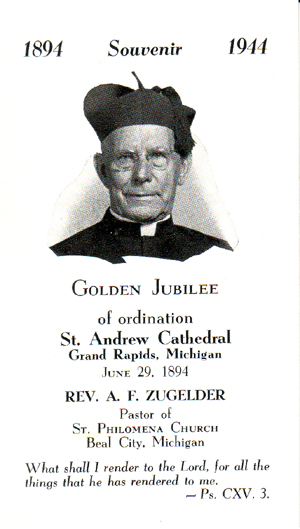
Golden Jubilee holy card for Father Zugelder. |
|
Sometime in the late 1940s, Will and Rose acquired Father Zugelder's cottage at Coldwater Lake and had it moved across the frozen lake during the winter to a new foundation built up the hill from their cottage. This second cottage accommodated their growing number of grandchildren.
Grand Rapids, 1950s-1960. Sometime in the late 1940s or 1950s, Father Zugelder became chaplain at Villa Maria, a retirement community in Grand rapids.
|
 Rev. Alexander Francis Zugelder
Rev. Alexander Francis Zugelder Rev. Alexander Francis Zugelder
Rev. Alexander Francis Zugelder Grand Rapids, 1888. In July 1888, Alexander emigrated at age 19 from Königheim to Grand Rapids, Michigan, where his Aunt Theresa Fassnacht Koch lived. There were 38 stars on the American flag when Alexander arrived. The last state to be admitted was Colorado. Grover Cleveland was President of the United States.
Grand Rapids, 1888. In July 1888, Alexander emigrated at age 19 from Königheim to Grand Rapids, Michigan, where his Aunt Theresa Fassnacht Koch lived. There were 38 stars on the American flag when Alexander arrived. The last state to be admitted was Colorado. Grover Cleveland was President of the United States.